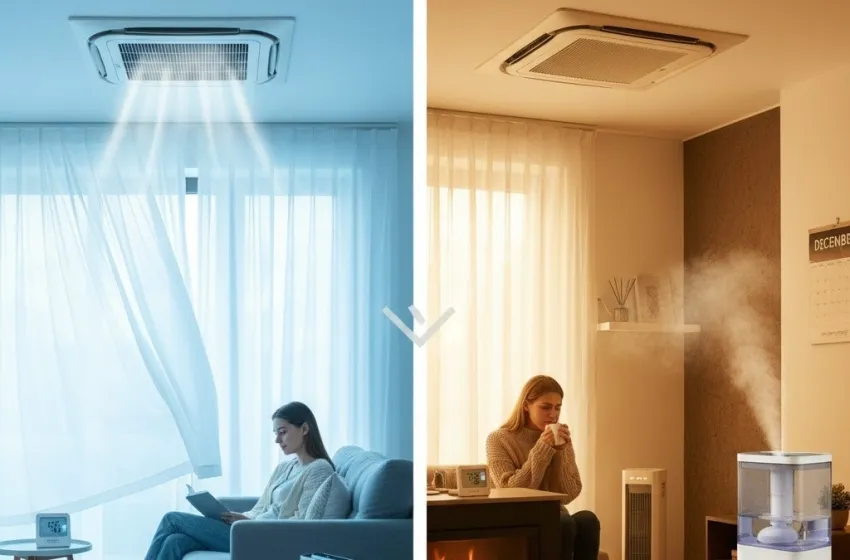Learn how air conditioning and dry air irritation from heating cause asthma flares.
For millions of people living with asthma, the very air they breathe can be a major trigger. While central air conditioning and heating systems are essential for maintaining comfort, the extreme fluctuations in indoor humidity they create can pose a significant challenge. Managing these seasonal changes is crucial for preventing airway irritation and keeping asthma symptoms under control.
Understanding Air Quality and Asthma Triggers
Asthma is a chronic condition characterized by inflammation and narrowing of the airways, often triggered by irritants or allergens. The air we breathe—both indoors and outdoors—is a complex mix of temperature, humidity, and particles, all of which can affect a sensitive respiratory system.
The Dual Role of Air Conditioning (Summer)
Air conditioning (AC) systems can be a great ally for asthma sufferers during hot weather, but they can also become a source of problems if not properly managed.
The Benefit: Allergen Reduction
By allowing you to keep windows closed, AC limits the influx of outdoor allergens like pollen and pollution. Modern units with efficient filters (especially HEPA-grade) actively clean the air, reducing the concentration of common indoor triggers like pet dander, dust, and dust mite particles.
The Risk: Mold and Cold Air
A major concern is AC maintenance. Air conditioners naturally remove moisture from the air, but the internal components—especially the coils and drip pans—can become damp, creating a perfect breeding ground for mold growth. If the unit is not cleaned regularly, it can circulate mold spores and other bio-aerosols throughout the home, leading to asthma flares. Additionally, breathing very cold air directly from an AC vent can constrict the airways and trigger a spasm in some individuals.
The Irritation of Dry Air in Winter and Summer
Both heating systems in winter and highly efficient AC systems in summer can dramatically lower indoor moisture levels, leading to dry air irritation in the respiratory tract.
Winter Asthma Flares and Low Humidity
When outdoor air is cold, it holds very little moisture. As indoor heating systems warm this air, the relative humidity plummets, often dropping well below the recommended therapeutic range of 40–50%.
Impact on Airways
The dry air causes the delicate mucous membranes lining the nose and throat to dry out. This reduces the effectiveness of the cilia—the tiny, hair-like structures that sweep mucus and trapped particles out of the lungs. The resulting nasal dryness and throat irritation can make the airways more vulnerable to viruses, bacteria, and airborne irritants, leading directly to winter asthma flares.
Impact on Sinuses
The low humidity thickens nasal mucus, making it harder to clear, which can lead to sinus congestion that worsens asthma symptoms.
Over-Dehumidification in Summer
While AC is necessary to reduce the excessive humidity that encourages dust mites and mold, running it constantly can over-dry the air, mimicking the dry air irritation experienced in winter. The resulting excessively dry environment can also leave the airways feeling raw and vulnerable.
Practical Tips for Managing Extreme Humidity Changes
The key to breathing easier is maintaining a stable, optimal indoor humidity level (ideally between 40% and 50%) year-round. This is where you actively manage the conditions created by your central air conditioning and heating.
Managing Dry Air in Winter (Heating Season)
Strategic Humidifier Use
Invest in a good-quality cool-mist or warm-mist humidifier for the rooms where you spend the most time, especially the bedroom. Humidifier use is the single most effective way to combat nasal dryness and airway irritation caused by heating.
Tip: Clean the humidifier daily or every few days with a diluted bleach or vinegar solution to prevent mold and bacteria from being released into the air.
Monitor with a Hygrometer
Use a simple, inexpensive device called a hygrometer to track the indoor humidity level. This prevents you from over-humidifying (which creates mold) or under-humidifying (which causes dry air irritation).
Stay Hydrated
Drink plenty of fluids. This helps keep the mucous membranes in your airways moist from the inside out, counteracting the effects of low ambient moisture.
Managing AC and Humidity in Summer
Prioritize AC Maintenance
Regular AC maintenance is non-negotiable for asthmatics.
- Filters: Change or clean your air filters every 1 to 3 months, especially during peak use. Use filters with a high MERV rating (11-13) or certified asthma & allergy friendly® filters to maximize the removal of allergens.
- Drip Pans and Coils: Have your system professionally inspected and cleaned annually to prevent microbial growth in the damp parts of the unit.
Use Dehumidifiers Sparingly
If your AC is highly efficient and already dropping humidity below 40%, turn off any separate dehumidifier. If your home still feels muggy, consider using the "dry" setting on your AC unit, which prioritizes dehumidification over cooling.
Control Temperature Fluctuations
Avoid setting the AC temperature dramatically lower than the outdoor temperature (e.g., more than 5°C to 8°C difference). Sudden shifts in temperature can trigger airway narrowing.
Conclusion
Air conditioning and heating systems are necessary components of modern life, but their impact on air quality and humidity is a constant factor for asthma management. By prioritizing regular AC maintenance, strategically utilizing humidifier use to maintain optimal indoor humidity, and being aware of the risks of dry air irritation that lead to winter asthma flares and nasal dryness, individuals with asthma can create a safer, more breathable home environment and significantly reduce the frequency and severity of their symptoms.
































